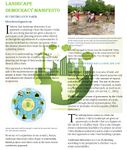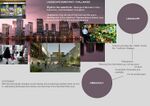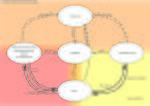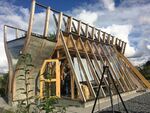LED Online Seminar 2018 - Working Group 13
--> Back to working group overview
Dear working group members. This is your group page and you will be completing the template gradually as we move through the seminar. Good luck and enjoy your collaboration!
Assignment 1 - Reading and Synthesizing Core Terminology
- You can read more details about this assignment here
- Readings are accessible via the resources page
Step 1: Your Landscape Democracy Manifestoes
Step 2: Define your readings
- Please add your readings selection for the terminology exercise before April 18:
A: Landscape and Democracy
B: Concepts of Participation
C: Community and Identity
D: Designing
E: Communicating a Vision
Steps 3 and 4: Concepts Selection and definition
- Each group member selects three relevant concepts derived from his/her readings and synthesize them/publish them on the wiki by May 9, 2018
- Group members reflect within their groups and define their chosen concepts into a shared definition to be posted on the wiki by June 6, 2018.
- Other group members will be able to comment on the definitions until June 12, 2018
- Each group will also report on their process to come to a set of shared definitions of key landscape democracy concepts on the wiki documentation until June 20, 2018
Concepts and definitions
Author 1: ...
- ......
- .......
- .......
Author 2: ...
- ......
- .......
- .......
Author 3: ...
- ......
- .......
- .......
Author 4: ...
- ......
- .......
- .......
Step 5: Reflection
Step 6: Revised manifestoes
- please look again at your initial manifestoes and update them with any new aspects/prespectives you have taken up during this seminar
Assignment 2 - Your Landscape Symbols
- You can read more details about this assignment here
Landscape Symbols Author 1: Andrea Haave Jenssen
The brand of the coffeeshop starbucks, A symbol of commersialization, homogenization and beginning gentrification in the old city of oslo, when the chain first opened in the area the glass to the shop was broken several times in the first period it was present, now it is actively being used by the multicultural inhabitants of the area and in a way represents both resignition to the ongoing processes and a will to keep the particularness of the area by taking ownership of the place and making it their own, picture from Oslo
Landscape Symbols Author 2: ...
- LED ASIGNEMENT2 ZACHELIN Benoit 1 (one paragraph max) description of the symbolism, interpretation, as well as geo-location
- LED ASSIGNEMENT2 ZACHELIN Benoit 2 (one paragraph max) description of the symbolism, interpretation, as well as geo-location
- LED ASSIGNEMENT2 ZACHELIN Benoit 3 (one paragraph max) description of the symbolism, interpretation, as well as geo-location
Landscape Symbols Author 3: Chiteri Louis Faber
Image:flag.jpg| Uhuru Gardens, Kenya’s largest historical point of reference located strategically along Lang’ata Road in Nairobi. “Uhuru” translates to “freedom” and it is at these same gardens that Kenya took its stuttering steps to self-rule. Mzee Jomo Kenyatta, first president of Kenya, was inaugurated here, and so was the first instance of hoisting the Kenyan flag. It is the only memorial park that symbolizes Kenya’s struggle for independence. The site still remains a unifying emblem among the residents of the country with it’s monuments that stand in the garden to date. In present day, the park is seen as a place to seek refuge away from the city’s buzz and hostility. The park is a symbol peace, love and unity.
Image:Memorial.jpg| Nairobi Bomb Blast Memorial garden
The park stands on the site of the former US embassy and serves to commemorate the dead and the survivors of the bomb blast of 1998.
In it is a wall with the names of the victims of the tragedy as the main monument. The park also features a designed landscape currently permitted to users at a small cost. It currently serves as a place for relaxation away from the city’s chaotic atmosphere.
Image:Mount-kenya.jpg| Mt. Kenya is a snow capped volcanic mountain in the equitorial of the earth, located in the cetral region of kenya, Nanyuki to be precise.
The mountain holds symbolic value in that during the precolonial period, the tribe living adjecent to it, the Kikuyu, attached their religious belief to the mountain. According to their history, the mountain wa their place of origin and belived that God resided there. The mountain was a shine and they prayed facing it.
Currently, the mountain acts as a tourist attraction site and still an important feature in the history of the still existing Kikuyu tribe
</gallery>
Landscape Symbols Author 4: ...
- Symbol yourname photovoice1
add a caption (one paragraph max) description of the symbolism, interpretation, as well as geo-location
- Symbol yourname photovoice2
add a caption (one paragraph max) description of the symbolism, interpretation, as well as geo-location
- Symbol yourname photovoice3
add a caption (one paragraph max) description of the symbolism, interpretation, as well as geo-location
Landscape Symbols Auther 3: ...
- Symbol yourname photovoice1
add a caption (one paragraph max) description of the symbolism, interpretation, as well as geo-location
- Symbol yourname photovoice2
add a caption (one paragraph max) description of the symbolism, interpretation, as well as geo-location
- Symbol yourname photovoice3
add a caption (one paragraph max) description of the symbolism, interpretation, as well as geo-location
Assignment 3 - Role Play on Landscape Democracy "movers and shakers"
- You can read more details about this assignment here
Assignment 4 - Your Landscape Democracy Challenge
- You can read more details about this assignment here
- Each group member will specify a landscape democracy challenge in his/her environment
Landscape Democracy Challenge 1
- Give a title to your challenge
- Yourname challenge 1.jpg
caption: why did you select this case?
- Yourname challenge 2.jpg
caption: what is the issue/conflict (1)
- Yourname challenge 3.jpg
caption: what is the issue/conflict (2)
- Yourname challenge 4.jpg
caption: who are the actors?
Your references:
- ...
- ...
Landscape Democracy Challenge 2
- Give a title to your challenge
- Yourname challenge 1.jpg
caption: why did you select this case?
- Yourname challenge 2.jpg
caption: what is the issue/conflict (1)
- Yourname challenge 3.jpg
caption: what is the issue/conflict (2)
- Yourname challenge 4.jpg
caption: who are the actors?
Your references:
- ...
- ...
Landscape Democracy Challenge 3
- Give a title to your challenge
- Yourname challenge 1.jpg
caption: why did you select this case?
- Yourname challenge 2.jpg
caption: what is the issue/conflict (1)
- Yourname challenge 3.jpg
caption: what is the issue/conflict (2)
- Yourname challenge 4.jpg
caption: who are the actors?
Your references:
- ...
- ...
Landscape Democracy Challenge 4
- Give a title to your challenge
- Yourname challenge 1.jpg
caption: why did you select this case?
- Yourname challenge 2.jpg
caption: what is the issue/conflict (1)
- Yourname challenge 3.jpg
caption: what is the issue/conflict (2)
- Yourname challenge 4.jpg
caption: who are the actors?
Your references:
- ...
- ...
Assignment 5 - Your Democratic Change Process
- You can read more details about this assignment here
- After documenting and reflecting on your challenges you will continue jointly with one of these challenges and design a democratic change process
Your Democratic Change Process
- Add Title
- Your Democratic Change Process Slide1.jpg
caption: ...
- Your Democratic Change Process Slide2.jpg
caption: ...
- Your Democratic Change Process Slide3.jpg
caption: ...
- Your Democratic Change Process Slide4.jpg
caption: ...
Reflection
- ....
- ....
- ....
Conclusion:
- ....
- ....
- ....
Your references
- ...
- ...
- ...







